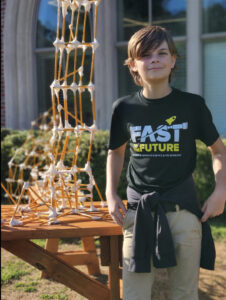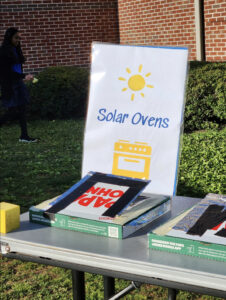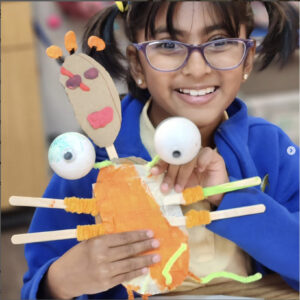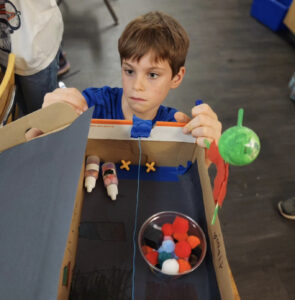



In 2020, FAST became an officially STEM certified school, with the report citing multiple programs both within the core curriculum and outside of it. But what specifically does STEM learning look like at FAST?
The call to action for FAST is the need for our children to be able to think critically, to develop deep and meaningful understanding of the world around them and how to create innovative solutions to problems.
Over the past two decades, children have developed a model to replication concept of education. Whether it is a math problem or a Lego kit in a box, children are shown a model and expected to replicate it exactly as a rote process. In school, children are given content information, tested to show they can replicate it accurately, but many lack the ability to think critically and cannot show meaningful understanding of the material in spite of high test scores. Without this understanding children cannot do something creative and innovative with the content. Focusing on STEM content only gets our children to the starting line. Creativity and innovation will get them into the race to win.
Since 1990 the scores among students taking the Torrance Tests of Creative Thinking have declined significantly, particularly in the K-3rd age range. Children who lose the ability to be creative also lose the ability to be innovative, which is the key to success in the 21st century global economy.
Children today have lost the tolerance to fail and to iterate. In today’s world of instantaneous results, children expect instantaneous correct answers. In The Price of Privilege, Dr. Levine describes how many children are unable to cope with even slight failure. To overcome this FAST will focus on a growth mindset to develop the habits of perseverance, intellectual curiosity, and creativity in our students.
The way FAST will accomplish this goal is three-fold. 1) FAST will incorporate Design Thinking into all facets of the school from each class a student attends to teacher development to administrative effectiveness. 2) FAST will add one hour each day to the school schedule, four days per week for a class in innovation for all grades, 3) FAST will have a capstone project for 8th graders lasting one year that will give each student the opportunity to demonstrate their innovation ability. Our differentiated math, science and literacy curriculum will support the goals in increasing critical thinking, deep understanding in content areas, creativity and innovation.
Science and Engineering education will work to align the ideals of constructivism and accountability, which are considered to be at odds in modern education research. In Redefining Smart, Mr. Markham shows there is a difference between being intelligent and having intelligent behavior. Intelligence is frequently considered to be genetically set, an unchangeable circumstance given to the privileged few.
Science
The curriculum FAST will use to support our students as they learn both content and intelligent behavior will be the Full Option Science System® (FOSS®) designed for K-8 and Engineering is Elementary® designed for grades 1-5. In line with the standards set forth by the Georgia Department of Education, the curriculum addresses both the content and the characteristics of science and will be used interchangeably or in conjunction with one another. EIE® will be used primarily in our lower grades as students gain facility with the design thinking process in a guided learning environment with hands-on activities. FOSS® is an investigation based approach to science education that is hands-on, follows an engineering design methodology to each investigation, and requires the integrated use of skills obtained in mathematics and computational thinking. Similar to our mathematics curriculum, FOSS® is also aligned to a mastery approach of learning. Fewer topics will be taught but with a much greater depth of understanding.
Technology
Students at FAST have computer science once a week starting in Kindergarten and continuing through fifth grade. In Computer Science students develop comfort with various forms of technology, write simple codes using “Scratch”, and learn how to be digital citizens of the world. In grades 6-8, daily coding is offered and is a requirement for all students. Here students are challenged to learn various programming languages and apply their understanding to complete coding challenges and projects.
Engineering
Engineering is a staple at FAST, woven into various programs. Many innovation projects offer opportunities to explore principles of structural and mechanical, from building towers and bridges from noodles to creating fully functioning solar ovens and wind turbines, from building wind-up cars to flying drones. Students have access to 3-D printers, a laser cutter, and robotics kits for their solutions to innovation problems and for their genius hour and capstone projects. At FAST, engineering is everywhere.
The idea of intelligence versus intelligent behavior deeply undermines students’ ability to persist in the face of failure, perhaps even more so among those that were gifted with greater intellectual ability at birth. Using constructivist theories in science and engineering class, students will be deeply engaged in learning that is personally meaningful causing the content of the learning to persist long past the test. Students will learn intelligent behavior by incorporating design thinking into project work. Project work will be at the core of the science and engineering curriculum at FAST.
FAST will seek ways to collaborate with external partners, including businesses, the community, and local colleges to gain access to real-world problem solving approaches used academically and professionally. Science and engineering project work will also integrate with writing projects in ELA as students develop opinion and argumentative writing pieces to support their scientific discoveries.
Fourth through eighth-grade students will use an engineering design-based rubric for evaluation. Notice the last column in the rubric entitled “breakthrough”. The standard rubric used by the Science Leadership Academy formed the basis of the FAST standard rubric.18 The FAST standard rubric adds the component of breakthrough as an expectation for our students. A student can get a 90 by showing mastery of the content but the only way to score 100 is to show creativity and innovation with breakthrough thinking. In How Google Works it is pointed out that people can be as limited by a set of goals as they are motivated by them. If one of the stated goals of FAST is to create innovative thinking than the standard by which we evaluate our students must reflect that goal. In order to get a “10” in breakthrough, a student will need to exceed the base rubric expectations and will need to demonstrate a novel solution, unusual insight or application, and “out of the box” thinking.